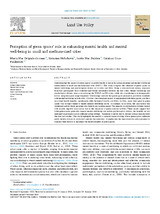Perception of green spaces' role in enhancing mental health and mental well-being in small and medium-sized cities
Autor
Delgado Serrano, María del Mar
Melichová, Katarína
Mac Fadden, Isotta
Cruz-Piedrahita, Catalina
Editor
ElsevierFecha
2024Materia
Urban Green SpacesMental well-being
Mental Health
Small and Medium-size Cities
Urban Planning
Nitra
Córdoba (España)
METS:
Mostrar el registro METSPREMIS:
Mostrar el registro PREMISMetadatos
Mostrar el registro completo del ítemResumen
Understanding the impact of green spaces on public health is crucial for urban planning and mental well-being enhancement in small and medium-sized cities (SMSCs). This study compares the influence of green spaces on mental well-being and psychological distress in Córdoba and Nitra. Using a cross-sectional survey, responses from 632 participants were collected and evenly distributed between the two cities. Mental well-being and psychological distress were assessed using the WHO-5 and K6 scales, while also considering sociodemographic factors and green space usage frequency. The findings indicate that green space perception positively correlates with mental well-being in both cities. However, the extent and nature of engagement with these spaces, and their associated health benefits, significantly differ between Córdoba and Nitra. In Nitra, more time spent in green spaces was strongly linked to higher mental well-being scores. In contrast, in Córdoba, this association was significant only for those spending over three hours in green spaces. The impacts on psychological distress varied, with notable negative associations tied to the frequency of green exercise in Nitra. These results suggest that while green spaces generally support mental well-being and reduce psychological distress, the benefits are not uniformly experienced across different urban settings. Variations could be due to distinct urban characteristics like size and weather. This study highlights the need for a nuanced understanding of how green spaces influence public health, tailored to each city's specific characteristics. It emphasizes the importance for urban planners to consider these factors to maximize the health benefits of green spaces.

